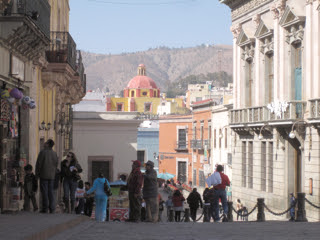Mexico – people, art and street life
There’s
always a buzz in the streets here, whether you’re
in Mexico City, Oaxaca, Playa del Carmen, Puebla, Taxco or Guanajuato, to name
just a few places. People going to or coming from work, people whose work is as
an “ambulante” –
a street vendor – people
delivering things, people selling things - notably food, kept warm in portable
ovens, from their modified bicycles.
Take the Tamale vendor in the Cuahtemoc neighbourhood of Mexico
City near the Stock Exchange and Paseo de la Reforma. He has been peddling his
bike around the streets here for years and has a “trade
mark” call, now modernised
with a continuous loop tape recording of his voice. Just on dinner time, when
busy people are either arriving home from work or just leaving the many office
buildings, he starts his rounds, calling out “Tamales
Calientes” (hot tamales)
and is regularly besieged by hungry customers. He works the streets until about
10pm, quelling the local hunger and appetites. Then there is the sweet potato
vendor, also on a bike with a special oven on board, and his trade mark sound
effect is not his voice but a steam whistle.
Many children also sell goods in the street, although this is
diminishing. But you can still see young kids, for example, selling cool drinks
in summer time. Then there are others who are reading or doing homework on the front steps of their house.
And of course, the balloon sellers are ubiquitous in every town!
And of course, the balloon sellers are ubiquitous in every town!
Sunday is a big family day in Mexico
City – it's home to about 25
million people – and many of the main museums have free admission on that day. Consequently,
most of the cultural venues have large crowds throughout the day. Chapultapec
Park, and enormous public park situated on a hill at the end of Paseo de la
Reforma, a huge, wide boulevard.
It is packed with families of a Sunday – all generations out together, enjoying the environment and, it would seem, each others' company. The park contains many of the city’s key museums and galleries, including the Anthological Museum, Rufino Tamayo Museum, the Modern Art Museum, the Museum of National History, Chapultapec Castle and the Natural History Museum.
It is packed with families of a Sunday – all generations out together, enjoying the environment and, it would seem, each others' company. The park contains many of the city’s key museums and galleries, including the Anthological Museum, Rufino Tamayo Museum, the Modern Art Museum, the Museum of National History, Chapultapec Castle and the Natural History Museum.
There are other venues for getting
people together to enjoy art. In the Jardin del Arte there is an exhibition put
on by local artists that showcases various media –
watercolours, oils, acrylics, photography and ceramics. The works are for sale
and you get to talk with each artist as you stroll about. We bought four pieces
from a lovely Mexican artist, Susana Lezama, who has exhibited work in London,
Cuenca and Barcelona in Spain, Basel in Switzerland, San Francisco in the US
and Havana in Cuba. We had two lively conversations with her, about Mexico and
life in general. Her speciality is still life, focusing on form, texture and
colour. Other artists reflected scenes from Mexican street life, landscapes and
abstract art.
Of course, there are the works of
world renowned Mexican artists like Diego Rivera, Frida Khalo, Rufino
Tamayo and countless others. Art
galleries are well attended, especially on Sunday and people flock in their
millions to the various museums, galleries and archeological sites.
It is interesting to me to see the
curatorial talent evident in their galleries, from the Museo de Arte Moderno to
a museum like the Franz Meyer in Mexico City. In the Franz Meyer, it is a real
test to exhibit a range of art forms collected over a lifetime by Meyer,
including painting, textiles, silver and gold, furniture and so on, in an
historic house. But they manage to bring it off very well – your curiosity peeked and
interest stimulated, rather than being overwhelmed by a jumble of “stuff”.

Equally, the Museo Nacional de
Antropologia has gradually renovated and redesigned how the various phases of
Mexican history are displayed. There are different galleries for the Mayan
period, the Aztec period and so on. The museum has a massive collection, but
through this modernisation process, they have culled and more dramatically
displayed key pieces. This curatorial approach has obviously met with the
approval of people, judging by the size of the crowds.
A similar level of interest with Mexicans is shown in the performing arts, for example at Belles Artes (their opera house) which is home to the world acclaimed Ballet Folklorico . The night we went, there were some tourists, but the majority in the audience were Mexicans, some possibly holidaying from other parts of Mexico, plus locals.
But the real buzz happens on the
street where normal, everyday things seem to take on qualities and scenes
perfect for a TV drama. Police chatting among themselves or talking to
potential suspects ...
Weddings, families dressed up for a special occasion, children selling cold drinks to help with the family budget ...
People assembling an art installation ....
Weddings, families dressed up for a special occasion, children selling cold drinks to help with the family budget ...
People assembling an art installation ....





































No comments:
Post a Comment